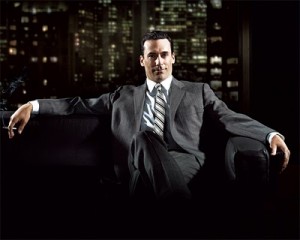Short Fuse: Meditating on the Psychedelic Realism of “Mad Men”
But there’s something else going on in Mad Men, all the more because it’s latent, unannounced, episode by episode. It’s this thing about art and advertising, and the difference, circa that era, if any.
By Harvey Blume.
In advance of its sixth season, beginning this coming Sunday, I’ve recently gorged myself on the fifth season of Mad Men.
At times I was enchanted. There were episodes that seemed dreamlike and subtly, quietly nightmarish, like David Lynch, but more subdued, or as remarked of Obama in his first debate with Romney, Ambienesque. Only invoking dream work could explain the subtle weirdness, the peculiar, off kilter interactions.
There were episodes that made me wonder why I was watching what was nothing, finally, but a soap.
And there were things that seemed completely off: riots breaking out everywhere, cities being torn apart in the late sixties, Harlem, for example, being burned, and barely a notice a few blocks downtown, at Sterling Cooper, on Madison Ave..
Maybe on Madison Ave. such things were, in fact, hardly noticed.
Then there’s Roger Sterling — head WASP, first lieutenant of the agency, the guy who after a swig or four, leads his unit over the hill, into fire — taking LSD in a trip that resembles no trip I’ve ever had or heard about, a nominal trip, a trip because the script says so. I gather we’ll be hearing, in season 6, about how this blank trip changed him, mysteriously, forever, yet.
As noted, it’s a soap.
Speaking of drugs, there’s Don Draper, the main Mad Man, sucking down nitrous oxide at the dentist. Nitrous oxide is laughing gas. Some people don’t like it. Many (like me) do. But nobody just hallucinates, as Draper does. The world may wobble and wiggle and you may finally if you get enough (not likely from a dentist) pass out, right after grasping the secret nature of things, but you never just see this guy you used to know looming above you in a realistic portrait as Draper does.
There should be standards, such a thing as psychedelic realism, as it were. Mad Men acts like nobody knows one high from another, as if everybody had always just said no. Maybe Mathew Weiner personally doesn’t have a clue, or maybe he suspects we can’t talk about such things honestly, and he can, therefore, get away with anything. Maybe he knows only, intimately, about nicotine and vodka.
But there’s something else going on in this series, episode by episode, all the more because it’s latent, unannounced, but omnipresent. It’s this thing about art and advertising, and the difference, circa that era, and ours, if any.
There’s hardly a scene without an art reproduction or original. In Roger Sterling’s high on the totem pole office, there is always what was then cutting edge art: color field; strong pulsing black and white abstraction.
Nobody talks about it. It doesn’t get a mention. It asks its own questions. How did it get there? Who procured it? Why was Sterling Cooper, on behalf of Madison Ave., encouraging such work? Why is it all over the place?
These ad men and women are obsessed with getting it right. They are driven by thoughts of money and success — bigger offices, better apartments — to be sure, but not only by those things.
They want to get it right much as the visual artists and writers who pass through the show want to. In both camps, there is an appreciation for and need to find the perfect pitch.


I am avoiding season 6 — taking place in 1968 — too close to my own memories. Early Mad Men was wonderful, a chance to visit my dad’s world in the late 50s and 60s — those offices, those clothes, those attitudes — for me it was nostalgia, but 1968 ? I would just as soon forget that year.
Art is not advertising.
Why are you so preoccupied with this idea of employing “realism?” More importantly, why do you continue to assert that Mad Men is a soap opera?
Soap operas are often driven by melodramatic plot twists and storylines. In Mad Men, it is not uncommon for a whole episode to pass without much taking place. This show is about character development, and one must be intensely aware of that if they are going to pick-up on all of the tiny nuances that make up each individual character. In addition to this, Mad Men is more literary than any other show on television. It strives for thematic unity across each episode and each season. The use of any “psychedelic realism,” as you put it, would undermine the point that is being made in this particular episode (the fact that Don’s past sins are slowly eating away at him).
Please do not look solely at the surface of this show. It is far more complex than you are giving it credit for. Give it a chance.